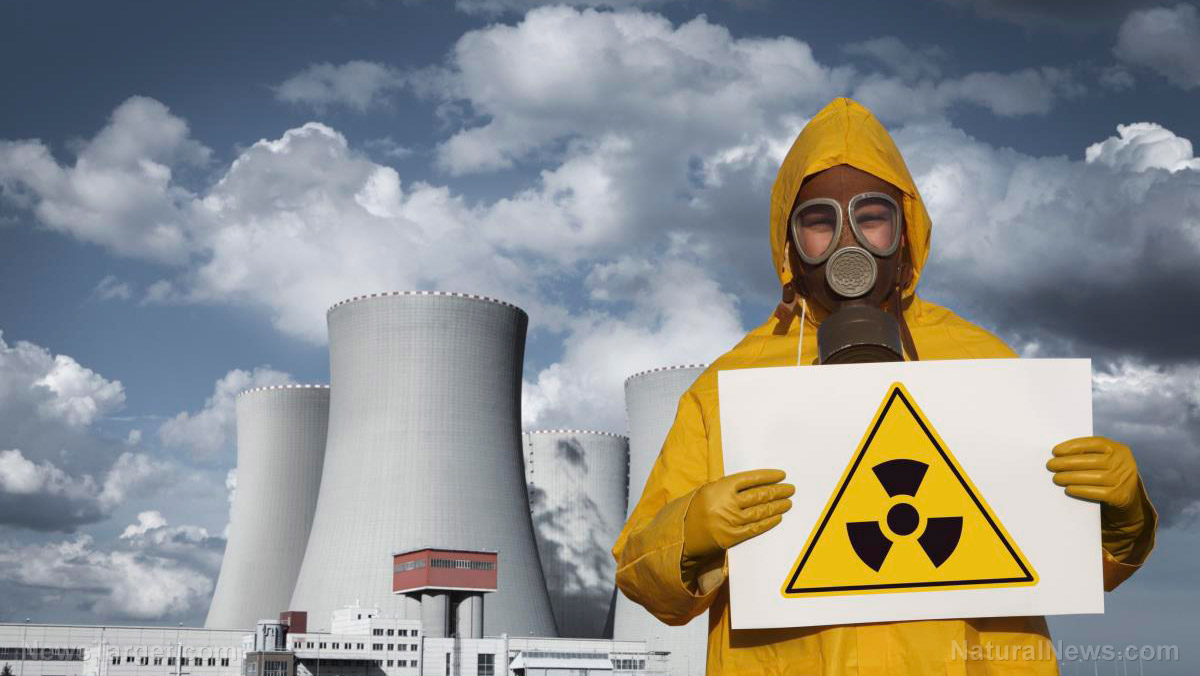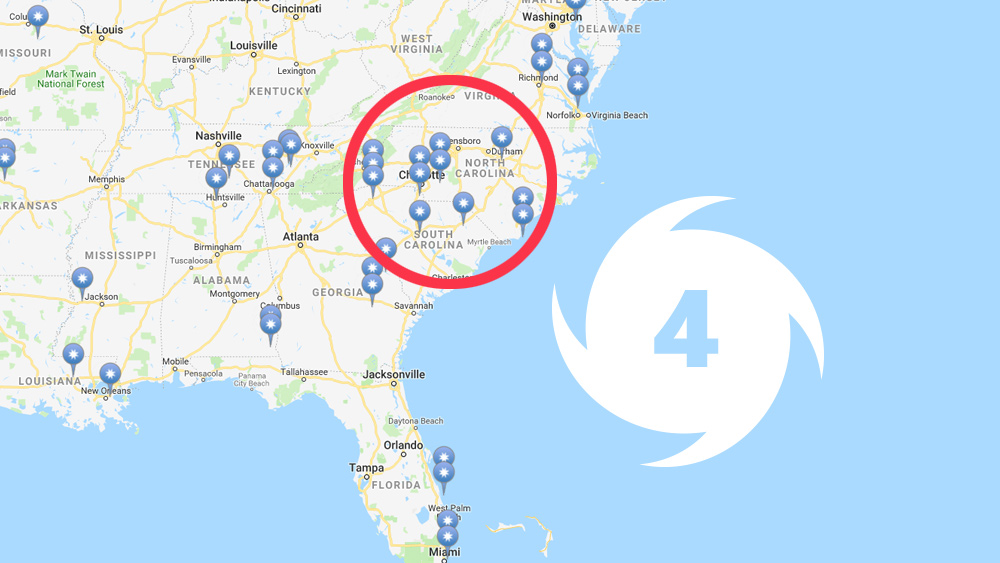
ALERT: The U.S. Nuclear Regulatory Commission has now declared an emergency at the Brunswick nuclear power facility due to extreme flooding. The facility is running a "hot shutdown" sequence, and all personnel are currently blocked from accessing or entering the structure. This has been declared an emergency "hazardous event" by the NRC. See full details here.
At least twelve operating nuclear reactors are in the predicted path of Hurricane Florence, which has been upgraded to a category 4 storm as it surges toward the U.S. East Coast. According to the U.S. Nuclear Regulatory Commission, which offers an interactive map of active nuclear reactors, two plants are vulnerable to both heavy rainfall and the expected storm surge which could bring a surge of up to 20 feet of ocean water pouring into coastal areas.
Those two reactors, located NE of Myrtle Beach, North Carolina, are known as "Brunswick Steam Electric Plant, Unit 1" and "Brunswick Steam Electric Plant, Unit 1."
Each unit produces nearly 1,000 MWe of electricity, and they are both built on the General Electric "Type 4" power plant design, which is almost identical to the GE nuclear power plant design used in the Fukushima-Daiichi reactors in Japan. All of these reactors are designed and constructed as "boiling-water reactors" or BWRs. The designs are decades old, and they are subject to catastrophic failures and even core meltdowns that release radioactive isotopes directly into the atmosphere and surrounding areas.
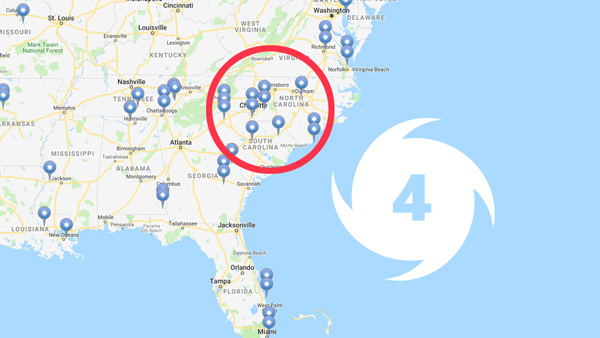
According to current forecasts, these nuclear power plants appear to be in the direct line of Hurricane Florence. Here's the current forecast from the NOAA, which brings the hurricane directly into North Carolina's coastline:
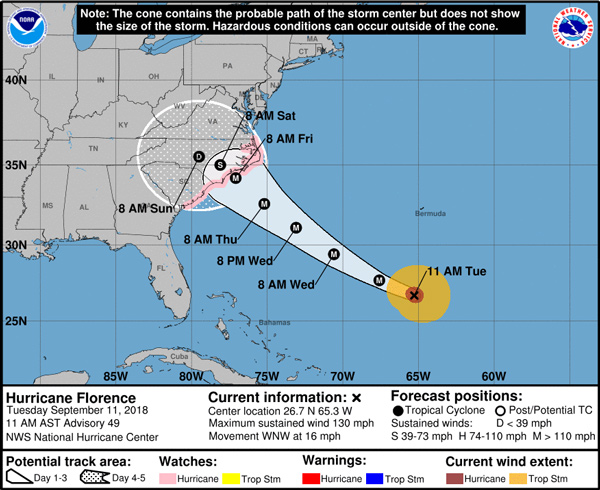
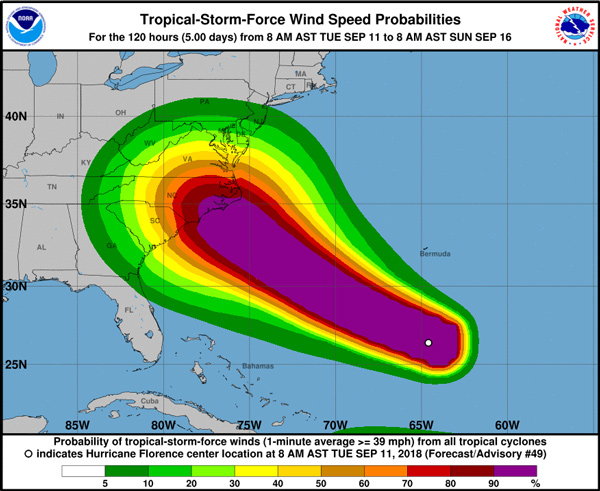
The Brunswick plant is a "Boiling Water Reactor" just like Fukushima
As this link from the U.S. NRC shows, the Brunswick Steam Electric Plant, Unit 1 is also a "Boiling Water Reactor." It was originally authorized for operation in 1976 and it licensed to continue operating through 2036. The following diagram shows how BWRs operate, using heat from the nuclear reactions to turn water into steam that drives steam turbines which generate electricity:
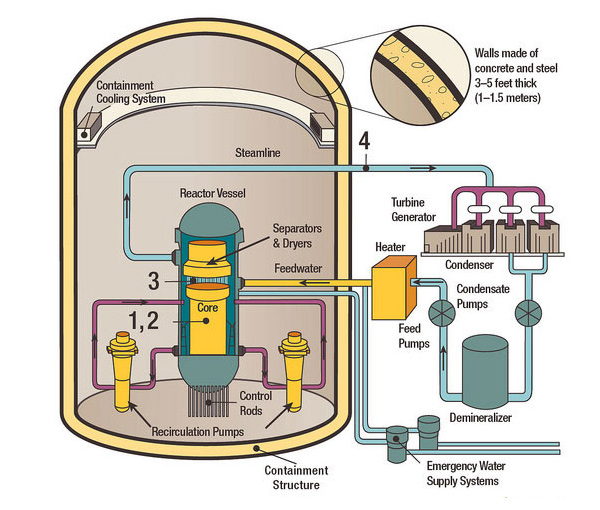
Boiling Water Reactor plants must sit at low elevation near rivers or lakes in order to have access to cooling water
BWR nuclear power plants rely on cooling designs that use large bodies of local water (rivers or lakes) to transfer heat from the nuclear power plant to the atmosphere. This heat transfer is necessary to prevent nuclear fuel rods from overheating and melting down in a runaway nuclear reaction. Importantly, this cooling operation relies on electricity to run the cooling pumps that circulate the water.
For this reason, U.S. nuclear power plants are equipped with multiple redundant cooling systems and backup generators that can run the pumps even if the local power grid is cut off. At the Fukushima-Daiichi nuclear power facility, both backup diesel generators and battery power systems were present.
You might wonder, then, how the electricity failed on all accounts, causing the cooling pumps to stop operating, ultimately leading to "criticality" of the fuel rods -- i.e. a meltdown. (For the record, the entire U.S. media lied about the Fukushima meltdown, claiming no meltdown had occurred. Only now, years later, does the media admit a nuclear meltdown took place. But in their original reporting, they universally claimed there was no meltdown. Just another example of how the media relentlessly lies about everything, not just politics.)
The answer is found in the storm surge -- a massive wave of ocean water that swept through the Fukushima facility, drowning the diesel generators, coolant pumps and backup batteries. In effect, Fukushima was inundated with ocean water, and everything stopped functioning. But the physics of the fuel rods was still operating, and you can't stop fission reactions just by hoping and wishing. So the fuel rods melted down and a nuclear meltdown took place, producing the Fukushima catastrophe we're all still suffering under today.
As the Nuclear Regulatory Commission explains on this page:
The reactor's core contains fuel assemblies that are cooled by water circulated using electrically powered pumps. These pumps and other operating systems in the plant receive their power from the electrical grid. If offsite power is lost, emergency cooling water is supplied by other pumps, which can be powered by onsite diesel generators. Other safety systems, such as the containment cooling system, also need electric power. BWRs contain between 370-800 fuel assemblies.
What the NRC doesn't explain, however, is what happens when all the electrical power and backup generators fail.
See my full threat analysis and preparedness wisdom in this Brighteon.com exclusive video:
The Brunswick power plant sits at a very low elevation, near the ocean
The concern among observers today is that the Brunswick Steam Electric Plant sits at a very low elevation in Southport, NC, just a few feet above sea level. The power plant sits directly on Cape Fear River, which was artificially modified to be used by the nuclear power facility so that coolant water could be drained into the ocean, just to the East. (Notably, Archer Daniels Midland also sits about half a mile away from this facility.)
To the East of the Brunswick power plant is Zeke's Island, a thin barrier between the Brunswick power plant and the Atlantic Ocean. Zeke's Island will of course be instantly under water if the expected 20' ocean surge achieves a direct hit on this area.
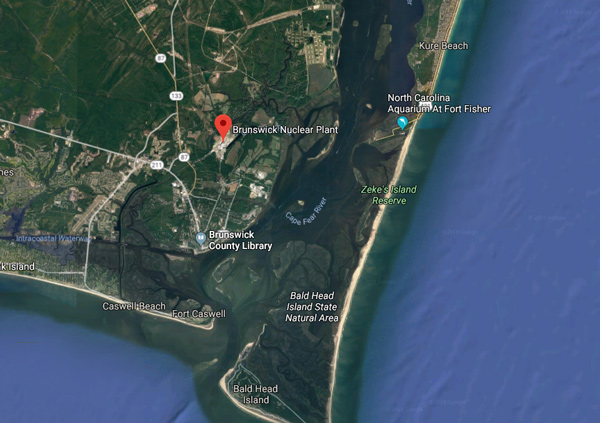
A 20' ocean surge would, without question, threaten the Brunswick nuclear power plant. To what extent, we can't say. Presumably, highly qualified technicians are preparing the power plant for the coming hurricane. Then again, Fukushima was also run by highly qualified technicians and really smart nuclear engineers who claimed a meltdown could never possibly take place. Take all official assurances with a healthy dose of skepticism (and perhaps a dosimeter as well).
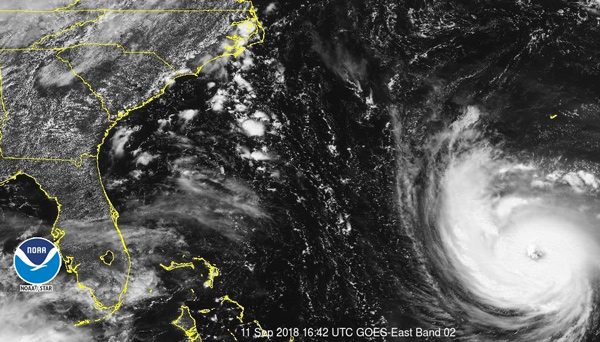
Nuclear meltdowns release radioactive Iodine-131
What's the big deal about nuclear power plants melting down and release radioisotopes into the atmosphere? The problem is found in the toxic mix of radioisotopes released in such catastrophes. Various isotopes are released, most notably including Iodine-131 and Cesium-137 (along with some other isotopes of uranium and plutonium, depending on the elemental composition of the fuel used).
Iodine-131 and Cesium-137 are extremely dangerous because of their relatively short half lives. In the realm of physics, a shorter half-life means the element is giving off radiation more quickly, releasing more energy into surrounding ecosystems or organisms (which could include you). In fact, the safer radioisotopes are those with very long half-lives, since they release relatively little radiation in any given time period.
Iodine-131 has a half-life of roughly 8 days. For purposes of simplifying things, we'll call it a week.
Cesium-137 has a half-life of roughly 30 years.
Note: As a matter of establishing some qualifications here, I'll remind readers that I'm the patent holder of a patent called Cesium Eliminator, a dietary supplement that was approved by the U.S. Patent and Trademark Office in 2014. You can read the patent here.
You can read about the invention, how it works, and the lab tests proving its efficacy at this link:
Cesium Eliminator is not for sale to the public. I am stockpiling the ingredients for Cesium Eliminator in Texas, where I have around 10,000Kg of the raw materials, ready to manufacture. I will only offer it (or donate it) to organizations when needed in a nuclear emergency.
I developed Cesium Eliminator as a way to remove cesium-137 from the digestive tract so that people who drink cesium-contaminated water or eat cesium-contaminated food can have a safe, effective way to eliminate cesium from their bodies. This avoids having the cesium absorbed into the bloodstream, where it circulates to internal tissues and irradiates the body from the inside, causing cancer, immunosuppression or death.
As the U.S. EPA testifies on its own website:
Cesium-137 that is dispersed in the environment, like that from atmospheric testing, is impossible to avoid... People may ingest cesium-137 with food and water, or may inhale it as dust. Like all radionuclides, exposure to radiation from cesium-137 results in increased risk of cancer.
It takes ten half-lives for radioisotopes to fall to a "zero"
Here's what you need to remember in all this: It takes about ten half-lives for radiation to fall to a level considered "zero."
For Iodine-131, that means 10 weeks. Here's how the physics works, roughly speaking:
Week 1: You're exposed to the FULL DOSE of Iodine-131 radiation
Week 2: You're exposed to 1/2 the dose
Week 3: You're exposed to 1/4 the dose
Week 4: You're exposed to 1/8 the dose
... and so on.
Iodine-131, of course, gets absorbed into the body through food and beverages (including cow's milk), where it tends to accumulate in the thyroid gland. This causes the irradiation of the thyroid gland from the inside, essentially "burning out" this gland, leading to lifelong health problems that can include cancer and death.
For this reason, U.S. government officials strongly encourage people to have supplementary Iodine available as a dietary supplement. When iodine is consumed as a supplement, the non-radioactive iodine elements are deposited onto the thyroid gland, "locking up" all the iodine receptor sites there (plus covering other iodine-ready organs such as breast tissue and prostate tissue), causing radioactive iodine to have nowhere left to go except to leave the body through normal elimination.
Thus, when people take supplementary iodine, they may prevent radioactive iodine from lodging in their body. This reduces total exposure time to the radioactive iodine, since it is naturally eliminated from the body over time. (Iodine and other elements have something called a "blood half life" which means how long it takes the body to eliminate them from circulating blood. Do not confuse this with the "physics half life" which refers to the transmutation of elemental mass into energy, over time.)
Where to get iodine at honest, normal prices, with no price gouging
For purposes of public safety, I'm going to list both the Health Ranger Store iodine and the InfoWars Store iodine products, which are offered at normal, everyday prices with no price gouging. Anyone wanting to have supplemental iodine on hand should immediately seek out these or other sources for supplemental iodine:
Health Ranger Store nascent iodine Preparedness Pack
Global Healing Center Detoxadine (Nascent Atomic Iodine)
FDA-approved ioSAT Potassium Iodide Tablets
InfoWars Store Iodine: Survival Shield X-2 Nascent Iodine
Note that nearly all of these are on sale at the moment, and probably all will be completely sold out due to the Hurricane Florence approaching disaster. If you need iodine immediately and can't wait for shipping from an e-commerce provider, you may still be able to go to your local health food store and purchase elemental iodine as a dietary supplement.
SAFETY ALERT: You cannot drink povidone iodine (the first aid topical liquid). It is toxic to swallow. However, many preppers believe that if you apply this solution topically, your body will absorb the elemental iodine through the skin, raising your blood iodine levels. This makes sense to me, but I have not personally tested this, so I can't vouch for it.
LAST-DITCH TIP: If you still cannot find any sources of iodine, you can eat large amounts of seaweed which also contain iodine from ocean water. I cannot recommend how much to eat: You should check with your physician or naturopath for that answer.
Bottom line: If the Brunswick nuclear power plant goes "Fukushima," it's over for the East Coast
It probably goes without saying, but if the Brunswick nuclear power plant goes into a meltdown, the entire U.S. East Coast would suffer unprecedented radiological contamination and disaster. This includes Washington D.C., Virginia, New York and perhaps even Boston, depending on wind speed and direction.
Obviously, we all pray this never happens, but we also know that nuclear industry "officials" are incompetent liars who routinely lie about everything, including nuke plant safety. Here's a photo of the Fukushima explosion (a hydrogen explosion) which the nuclear industry -- and General Electric officials -- swore could never happen:
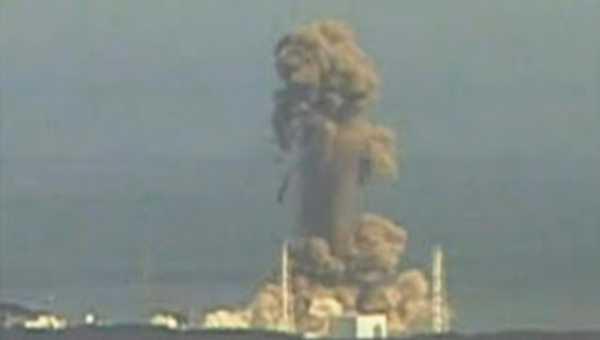
Now imagine that on the U.S. East Coast. This is the scenario we're all concerned might happen if all the wrong events converge.
My advice? Stay prepared. Evacuate the area if you can. Get some iodine just in case, and have stored food, water filters and other obvious emergency supplies at the ready.
Prepare for the worst and pray for the best. With a little luck, we'll all get through this and things will return to normal after the storm passes.
Read more stories on nuclear power at Nuclear.news.
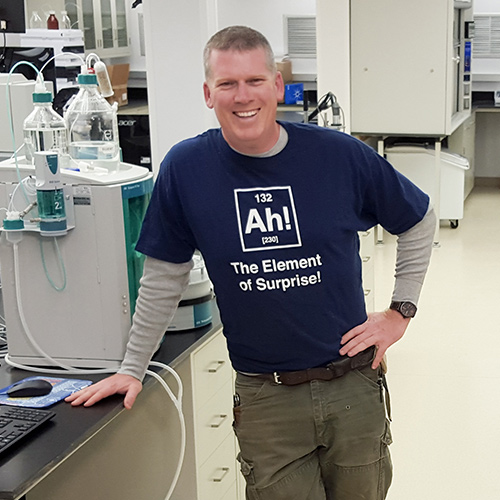
Mike Adams (aka the "Health Ranger") is the founding editor of NaturalNews.com, a best selling author (#1 best selling science book on Amazon.com called "Food Forensics"), an environmental scientist, a patent holder for a cesium radioactive isotope elimination invention, a multiple award winner for outstanding journalism, a science news publisher and influential commentator on topics ranging from science and medicine to culture and politics.
Mike Adams also serves as the lab science director of an internationally accredited (ISO 17025) analytical laboratory known as CWC Labs. There, he was awarded a Certificate of Excellence for achieving extremely high accuracy in the analysis of toxic elements in unknown water samples using ICP-MS instrumentation.
In his laboratory research, Adams has made numerous food safety breakthroughs such as revealing rice protein products imported from Asia to be contaminated with toxic heavy metals like lead, cadmium and tungsten. Adams was the first food science researcher to document high levels of tungsten in superfoods. He also discovered over 11 ppm lead in imported mangosteen powder, and led an industry-wide voluntary agreement to limit heavy metals in rice protein products.
Adams has also helped defend the rights of home gardeners and protect the medical freedom rights of parents. Adams is widely recognized to have made a remarkable global impact on issues like GMOs, vaccines, nutrition therapies, human consciousness.
Please contact us for more information.
















